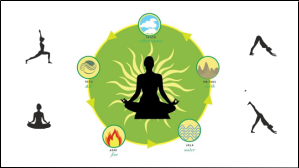Discover Ayurveda With Daadi Planet

Are Ayurveda and Yoga related?
Achieving optimal well-being is a universal aspiration, yet the relentless pace of modern life often poses challenges. Many individuals are turning to ancient practices like yoga and Ayurveda to address the escalating issues of stress, anxiety, depression, and disrupted eating patterns. For contemporary women seeking perfection, the key lies in embracing the rejuvenating powers of yoga and a nourishing application of Kumudini face glowing oil. This unique blend aids in restoring the skin’s natural radiance by eliminating dark spots, scars, blemishes, and wrinkles. Crafted entirely from Ayurvedic ingredients, this product effortlessly fulfills all your skincare needs.
Diving into the realms of Yoga and Ayurveda, these terms are gaining prominence in today’s society, each contributing to a holistic lifestyle. However, there is often confusion surrounding the distinctions between the two. This article aims to dispel any uncertainties surrounding Yoga and Ayurveda.
Yoga, a significant facet of the six Vedic philosophical traditions, is renowned for its formulation in Patanjali’s Yoga Sutras. These traditions aim to systematize the meanings of the authoritative Vedas, with Yoga permeating all six disciplines to varying degrees. Representing the practical aspect, Yoga lays the groundwork for cultivating a contemplative mind, serving as the core of Vedic wisdom.
In contrast, Ayurveda, a Vedic philosophy, is primarily designed for therapeutic purposes within the original Vedic framework. It stands as the sole Vedic healing practice alongside Yoga, which is a spiritual practice system known as sadhana. Yoga serves as an integral component of all Vedic sadhanas or spiritual practices.
These ancient Vedic sciences, Yoga and Ayurveda, have coexisted for centuries, addressing the body, mind, and spirit’s well-being. While Ayurveda focuses on bodily health, Yoga is dedicated to purifying the mind and consciousness. Despite their distinct emphases, the two disciplines complement and embrace each other harmoniously, as described in the ancient Sanskrit texts, the Vedas.
The foundational gurus of Vedic studies, the historic rishis and scholars, recognized the intrinsic value of robust health in the pursuit of self-realization. Ayurveda and yoga, as mutually beneficial practices, offer various methods for preventing and treating ailments, as well as purifying and rejuvenating the body. The synthesis of Yoga and Ayurveda, as advocated by the ancient gurus, represents the ultimate healing solution.
Emphasizing the significance of herbal remedies, Kumudini face glowing oil stands out as a natural elixir crafted from 28 rare herbs. Enriched with the wisdom of Ayurveda, this oil caters to all skin types. Those with oily skin can apply a moderate amount, rinsing after an hour, while individuals with dry or normal skin can generously apply and leave it overnight for optimal results. Don’t hesitate – procure your bottle of Kumudini face glowing oil today and witness the transformative effects. With the advent of summer, prioritize your skin health without breaking a sweat, thanks to Kumudini face glowing oil.



History of Yoga and Ayurveda
While the Vedas are considered shruti, the yogic teachings, classified as smriti in The Bhagavad Gita, date back to around 200 BCE. The Bhagavad Gita recounts the narratives of Arjuna, a king, and Krishna, his celestial charioteer. The script defines Yoga as a harmonious blend of balance, emotions, intellect, behaviors, and selfless deeds. Simultaneously, Patanjali’s Yoga Sutra, spanning between 500 BCE and 400 AD, captures the essence of yogic teachings transmitted from gods to yogis through oral traditions.
The practice of Asana, a physical aspect integral to the yoga journey, has been part of the tradition since the 11th century. Hatha yoga poses, designed to calm the nervous system, lay the groundwork for effective meditation. Contemporary yoga draws inspiration from both ancient texts and the hatha yoga tradition, creating a synthesis that resonates with modern practitioners.
In contrast, Ayurveda, recognized as a comprehensive medical system, traces its roots back to the Vedic period, estimated to be around 5,000 years old. The Vedas document medical knowledge passed down from gods to gurus, physicians, and therapists, with extensive discussions on herbs and medications. Subsequent scripts, including the Sushruta Samhita, an ancient medical and surgical literature, recommend exercise and Vedic study for recovery. Despite its ancient origins, Ayurvedic traditions were introduced to the contemporary world only in 1970, unveiling a wealth of holistic healing practices.

Few Similarities Between Yoga and Ayurveda
Yoga and Ayurveda, rooted in ancient Vedic traditions, find their origins in different Vedas—Yoga is derived from the Yajur Veda, while Ayurveda draws inspiration from the Atharva Veda and Rigveda.
Both disciplines share the understanding that maintaining physical health is integral to achieving the four fundamental goals of Dharma (duty), Kama (desire), Artha (wealth), and Moksha (Liberation).
A common thread in Yoga and Ayurveda is the acknowledgment that a focus on health necessitates a delicate balance of doshas (humors), dhatus (tissues), and malas (waste products).
Both systems boast a metaphysical anatomical structure, encompassing elements like 72000 nadis (subtle channels), 7 primary chakras (energy centers), 5 body sheaths, and kundalini shakti (energy).
Bodily cleansing methods play a crucial role in both Yoga and Ayurveda, albeit through different approaches. Yoga employs shat karma (Six purification measures), while Ayurveda embraces panchakarma (five cleansing activities) to facilitate the removal of waste items and toxins through organic excretion pathways.
For holistic well-being, both recommend a combination of Ayurvedic remedies, asana, pranayama, mindfulness mantra, astrological prayer, puja (worship), and rites.
Emphasizing the interconnectedness of physical, mental, moral, and spiritual well-being, both Yoga and Ayurveda underscore the importance of physical health as the foundation for a fulfilling life.
In the realm of psychology, both systems share similar perspectives. Ayurveda encompasses all six major lines of thought, including Patanjali’s Vedanta and yoga sutras. They both recognize that the body-mind connection is the root of all challenges and emphasize that optimal health is achieved when one remains aligned with their inherent nature—characterized by complete tranquility, independent of external circumstances.

Significance of Yoga and Ayurveda in Our Lives
In the face of escalating medical needs and the subsequent surge in costs, the significance of Ayurveda and Yoga practices becomes even more pronounced, offering a holistic and cost-effective approach to life. These practices pave the way for a stress-free mind and body, contributing to an extended and fulfilling life.
The impact of Ayurveda and Yoga on well-being is multifaceted:
Detoxification and Rejuvenation: Regular practice of Yoga and mindfulness meditation aids in detoxifying and rejuvenating the body, fostering a sense of overall well-being.
Stress and Anxiety Relief: Recognized as the most effective stress and anxiety relievers, these practices promote mental tranquility and emotional balance.
Enhanced Mental Focus: Yoga and mindfulness address emotional turmoil while enhancing attentiveness, resulting in improved mental focus.
Digestive Health and Metabolism Boost: These practices contribute to the maintenance of good digestion, boosting the body’s metabolism and overall digestive health.
Joint Health and Pain Management: Controlling inflammation, alleviating aches and pains, and supporting joint health are additional benefits of incorporating Ayurveda and Yoga into daily life.
Anti-Aging and Skin Health: Reducing the aging process, promoting healthy and youthful skin, and enhancing skin glow are achieved through practices like Yoga, complemented by natural skincare products like Kumudini face glowing oil.
Body Cleansing and Weight Management: The holistic approach of Ayurveda and Yoga facilitates body cleansing and aids in weight loss, promoting overall physical health.
Yoga, specifically, offers a myriad of advantages, such as promoting heart health by lowering blood pressure and cholesterol levels. Regular yoga practice contributes to the development of strength, stability, and flexibility, essential components of overall physical well-being.
Moreover, Yoga and Ayurveda foster improved self-care practices. To enhance your self-care routine, Kumudini face glowing oil serves as a natural and Ayurvedic solution for achieving glowing, supple, and soft skin. This oil, rich in Ayurvedic properties, addresses concerns like dark spots, scars, blemishes, and wrinkles, providing comprehensive skincare. Embrace the holistic benefits of Yoga and Ayurveda, and elevate your well-being by incorporating Kumudini face glowing oil into your daily skincare regimen. Order your pack now and experience the transformative effects on your skin health.

Conclusion
In conclusion, the harmonious integration of Yoga and Ayurveda is paramount to unlocking the complete therapeutic and spiritual potential inherent in each practice. By seamlessly blending Ayurveda into Yoga, a holistic yogic and Vedic medical system emerges, allowing all facets of Yoga to contribute to healing. This integration extends beyond physical postures, incorporating Yoga-inspired care, prognosis, and herbal interventions that align with the spiritual orientation of Yoga. Conversely, infusing Yoga into Ayurveda therapy introduces a psychological and spiritual dimension to treatment, preventing Ayurveda from being reduced to a mere prototype and enabling the realization of its full Vedic healing potential.
Ayurveda provides essential lifestyle guidelines for effective Yoga practice, establishing the foundation to fully harness the therapeutic benefits of all aspects of Yoga. Meanwhile, Yoga imparts a psychological and spiritual underpinning to Ayurveda, enhancing its overall applicability. A holistic and psychological approach to treatment and recovery necessitates both Yoga and Ayurveda, with Ayurveda offering the medical framework and Yoga providing spiritual aims and practices—this echoes the original Vedic system.
The restoration of the symbiotic relationship between Yoga and Ayurveda serves as the cornerstone for a comprehensive Yoga practice and Yoga medicine. This reunification not only sets the stage for meaningful dialogues with medical advancements but also addresses the root causes of illness, fostering societal well-being. As we contemplate the ideal fusion of Yoga and Ayurveda, consider incorporating Kumudini face glowing oil into your daily skincare regimen. This 100% Ayurvedic oil, devoid of chemicals, is crafted from 28 unique herbs, including Gorochana, Pasupu, Kamala Puvulu, Nelamulaka, Marrimanu, and Yestimadhu, blended with Sesame oil. Don’t wait any longer—order your Kumudini face glowing oil now to enrich your skin with the pure essence of Ayurveda and experience the transformative effects on your skin health.
